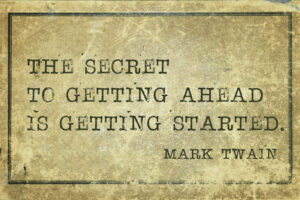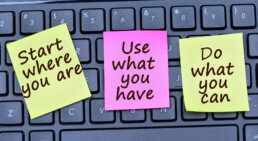Overwhelmed?
Do you ever feel overwhelmed? There’s just too much happening at once. You have bills to pay, appointments to make, places to go, organize your house and maybe your office, assignments due, people to take care of, and so on.
 Or have you ever been in a restaurant full of people talking at other tables, and a musician singing loudly in the background?
Or have you ever been in a restaurant full of people talking at other tables, and a musician singing loudly in the background?
What you might be experiencing is sensory overload. When I’m trying to write a newsletter, and someone is mowing their lawn nearby, and a large truck is rambling up the road, and my husband is trying to talk to me, and the phone is ringing, and my sweater itches…you get the picture—sensory overload.
Overwhelm and overload are both too much.
When overwhelmed, take control of your schedule by deciding what’s important and what can wait.
With overload, if you can cut out distractions – put the phone on silent, put on a comfy sweater – do. A pair of noise-canceling earphones can do wonders with overload.
Life happens, there’s no controlling that. It’s up to you to realize it’s normal and find solutions that work for you.
- Sydney Metrick
Three Really Great Problem Solvers!
Do any of these sound familiar?
- You have a great idea in the shower and then forget it by the time you’re dressed.
- A task you thought might take an hour actually takes three.
- You sometimes get so caught up in one thing that you’re late for something else.
- Prioritizing your schedule to address all your “to do’s” feels impossible.
 Solutions exist. I like things to be simple and easy to use so these three tools have passed muster. They are AquaNotes, Time Timer, and Planner Pads.
Solutions exist. I like things to be simple and easy to use so these three tools have passed muster. They are AquaNotes, Time Timer, and Planner Pads.
- Because they say it best, I’m just going to quote from the AquaNotes website: “If you find that some of your best ideas and insights are generated in the tranquility and solitude of the shower...then AquaNotes® is for you! These waterproof notepads help you capture and preserve your ideas before they're forgotten!” The 40 sheet, refillable pad suctions to your shower wall and even comes with matching pen.
- Time Timer has a line of timers, watches, and applications that helps you stay on track. By setting the amount of time you want to spend on a task, Time Timer provides a bright visual of the time gradually elapsing – letting you know when you are getting to the finish – and an alarm to tell you when you are done and need to move on.
- The Planner Pad is an easy-to-use system that help you organize, prioritize, and schedule in ways that make sense. They even have a way of keeping track of items that didn’t get done.
Even the websites are user friendly. Check them out. Let me know if you start using any of them and tell me about your experience.
- Sydney Metrick
If Not Now, When?
Are you familiar with Dr. Seuss’s, “The waiting place?”
“Waiting for a train to go or a bus to come, or a plane to go or the mail to come,
Or the snow to snow or waiting for a Yes or a No, or waiting for their hair to grow.
Everyone is just waiting.”
Are you waiting for the time to be “right” to start a task or a project, especially a big project or a less than exciting task? The truth is when a project feels too big to know where to start, or a task is tedious, the time will only be right when you actually decide to start.
There are many reasons for procrastination and only one solution.
 Starting.
Starting.
Fear not. Starting is not the same as finishing, and knowing the best place to start is not necessary. Starting just means taking one small step…then another.
Sometimes a project or task can be easier with chunking. That means breaking it into either time chunks, e.g. “I will spend ten minutes on this,” or chunks of items or work. For example, just go through one pile, or writing one page.
If “now” really isn’t the ideal time to start, then schedule a “now” and stick to it!
You may be familiar with the Chinese proverb that says: “The best time to plant a tree was 20 years ago. The second-best time is now.” So, forget about waiting.
-Sydney Metrick
What’s Your Name Again?
Does this ever happen to you? You’re at an event and get introduced to someone and find their name is gone almost as soon as you hear it. This is common for those of us with short-term or working memory challenges. Perhaps you go to the store to pick up a few items, let’s say coffee, cereal, and juice. While holding the cereal and juice you run into an acquaintance and have a brief conversation. Paying for your items and arriving back home you realize you totally forgot the coffee.
 When I was teaching, a pop-up thought would sometimes arise related to the subject, or a student would ask something that stimulated another relevant concept. Knowing I’d be likely to completely forget those random thoughts, I trained myself to make a small note on my lesson or the whiteboard.
When I was teaching, a pop-up thought would sometimes arise related to the subject, or a student would ask something that stimulated another relevant concept. Knowing I’d be likely to completely forget those random thoughts, I trained myself to make a small note on my lesson or the whiteboard.
Meetings were also a problem for me. I used to blurt out random thoughts – rudely interrupting – afraid of losing them. Finally, I realized that making a note of my thought was a much safer way of preserving my ideas.
The most annoying problem for me was putting something important in a “safe place” and then having no idea where that place was. I finally realized that it’s much easier to have a few safe places that I used every time. Even then I started putting notes in my calendar saying something like, “find check for Fri. appt. w/kitchen knives.”
Little reminder notes work well for me. Lists for shopping help lots. Many people find that their phones are great places for lists and reminders – others just find them annoying.
As for names, the best I’ve come up with is, “Sorry, I just spaced out on your name.”
-Sydney Metrick
Solutions to What Might Ail You
- Would you say you are easily distractible, either by things around you or competing thoughts in your head?
- Is impulsivity kind of a problem for you in relationships? Interrupting, blurting, being snappish?
- Do you get restless if you have to be in one place or focus on one less-than-fascinating thing for too long?
- Does your memory seem to be out of order when it comes to remembering names or appointments or … Hey, why am I in the kitchen anyway?
- What about time management? Do you find prioritizing a challenge? Is planning, short or long-term, a foreign concept?
Here are some tips:
Distractibility due to external factors may be addressed by finding or making a quiet spot to focus. Perhaps a white noise machine to minimize external sounds. Distracting thoughts can be important. If so, have a pad handy to jot them down for later.
 Impulsivity displayed as interrupting or blurting might also positively respond to the “I must take a note so that I remember” idea. You might also say something like, “Excuse me for interrupting, …” Snappish? Look at the common triggers and practice alternative responses.
Impulsivity displayed as interrupting or blurting might also positively respond to the “I must take a note so that I remember” idea. You might also say something like, “Excuse me for interrupting, …” Snappish? Look at the common triggers and practice alternative responses.
Restlessness takes many forms. Get familiar with your average attention span and give yourself permission to do things in short blocks of time, rotating between things that must be done. Take breaks – and return from them.
Memory issues are so frustrating, aren’t they? Calendars are a huge help. This means calendaring appointments, big tasks, and those things you want to do for yourself. Add both start and due dates for the project. Use your calendar as a commitment book and check it throughout the day.
A visible bulletin board with colored sticky notes and reminder alarms on your phone are other good tools.
If time management is one of your challenges, a calendar might help with this, too - provided you check it religiously. Setting phone reminders and responding to them can help. Also setting a timer, even a kitchen timer, for how much time you realistically can spend on a task keeps you from getting lost in hyperfocus. Finally, since it may be difficult to estimate how much time something will take, add a time cushion.
These are just a few of the tools that can make a difference…if you use them. The tool we all need to use is the honest desire to stay focused, not interrupt, remember what we’re doing, and keeping our time – if not the rest of us – organized.
If you have the desire, I have other tools I am happy to share with you. Just contact me.
-Sydney Metrick
Check Please
You know that phrase, “It seemed like a good idea at the time”?
In the western film, "The Magnificent Seven," Steve McQueen, in the role of Vin, gives an example worth watching.
The thing is, what seems like a good idea at the time or in the moment, may have consequences that, in retrospect, lead more to “What was I thinking?”

We’re all plagued by impulsivity from time to time; but for those with ADHD, impulsivity may be an ongoing challenge. Fortunately, there is a process that can broaden the sense of time so that actions taken in the present are seen to have repercussions in the future. Think of it as a future check.
First, you have to be aware that you are making a decision about something. This can actually be the hardest part. Instead of just going along with the moment, stop and acknowledge that you are actually making a decision to do/not do something.
Call this your decision point. It’s like standing at a fork in the road and determining the way to go. Be there two or multiple options, you are now at step two in the process.
Second, use “if/then” thinking to consider your choices. Examples would be, “If I hang out on the internet instead of writing my newsletter, what would that mean to me and my business tomorrow or next week?” Or, “Those lemon bars are my favorite dessert. If I eat four of them (which would be so delicious and my mouth is watering) how will I feel later today and will my pants fit tomorrow?” Or, “How about I buy myself one too? Will I be able to pay my mortgage at the end of the month?”
Those of us who are not linear thinkers tend to make “in the moment” decisions based on what feels good right then. However, this month, with all the opportunities for buying and eating more than we need or can afford, it’s an excellent time to develop the habit of stopping at a decision point and considering consequences.
-Sydney Metrick
“Now where did I put my…?”
Does this ever happen to you? You’re carrying a few bags of groceries from the car to the house. In a hurry to go out again later that day, you’re distressed to discover your keys are nowhere to be found.
There are only so many things you can fully attend to at a time. When you’re engaged in a conversation, or have ten things on your mind something as “trivial” as where you set something down may not shoot right past your short term memory.
My uncle Leon would have his glasses pushed up on top of his head. Look all over the house for them and offer me a quarter if I could find them for him. That was the easiest quarter I ever made. Like Leon, everyone misplaces things from time to time-you put your keys in your pocket because you’re carrying a few bags, hang up your jacket and later wonder where your keys are, or put your phone down to get some information in another room then return and don’t remember where you set the phone.
Two solutions. Places where you always (okay almost always) put certain items, like keys, phone, wallet, shoes. It’s kind of like having the address for them. Once you develop the habit, chances are lots higher that you’ll find your items where they belong.
But sometimes you won’t put things where they belong, right? Even if you’re in a rush, stop. Sit down. Close your eyes and breathe. Think about what you were doing when you last had the item. Recreate your steps. Do this as calmly as possible.
How do you decide where something “belongs” anyway? Have you ever put something important in a safe place and then forgotten just where that place is? Again, having a special safe place that you use all the time can make a huge difference. Trust me. I still haven’t found two hundred dollar bills I put safely away last fall.
Wouldn’t it be Nice if…
Let’s play a game. It’s called “Wouldn’t it be nice if…”
Here’s how to play-- think of something specific you want to do, have, or be. Add that to the framework. For example, “Wouldn’t it be nice if I got eight hours of sleep,” or “Wouldn’t it be nice if it was easy for me to prioritize.”
Sure, there are some things that would be nice … winning the lottery, finding the fountain of youth, having a chauffeur. But those may be just a bit beyond your reach. However, sufficient sleep or being able to prioritize are totally doable. That is if you really want them and are ready to make it happen.
John Asseraf said, “If you’re interested you’ll do what’s convenient; if you’re committed, you’ll do whatever it takes.”
Sometimes it’s easier to know what you don’t want than what you do want. So get clear about what you really want. Can you imagine being the person who does what it takes to have what you say you want?
- Do you believe you can have it, that you deserve to have it?
- Do you really want it or just think it would be nice?
- Finally, are you ready to do whatever it takes?
Let’s look at your answers:
- If the answer to #1 is “not sure” or “no” you might want to start smaller and work your way up to your bigger, ultimate goal.
- How about #2? Do you think you “should” want to do, have, or be whatever you have in mind? For example, you have friends with new cars and you have an old Toyota that you actually love, but wonder what kind of statement it makes about you. I am anti-should, so don’t let others tell you what you feel. On the other hand, it never hurts to get an outsider’s opinion on how your image is impacting your reputation.
- Number #3 is easy. If you’re ready, it’s good to have support. Here’s where I can help. As a coach, I help you clarify your goals, create realistic action plans, schedule the steps, work through obstacles, and get results.
The Magic of “What if…”
Are you satisfied with the results of your actions (or lack of actions)?
Consider this cycle:
- You hold certain beliefs, such as “I’m not a person who…” or “I can’t use a calendar.”
- When you think about doing one of those things, you feel apathy or even defiance.
- The unpleasant or negative feelings lead to avoiding actions that would have furthered you towards a goal.
- You don’t like the results you do get and possibly feel a bit of self-recrimination.
The results become evidence and the cycle continues.
Beliefs lead to thoughts which bring about feelings that influence behaviors and consequently results.
When you repeatedly get results that do not support your goals or your happiness it’s time to stop and consider what could be in the way. What if you interrupt the “I’ll do that later…” or “It’s too hard…” or any other sad excuse? What if you notice when you have a thought that is likely to interfere with an intended action? What if you reflect on how you’ll feel later if you avoid following through with your intention? What if you disregard the excuses and take the intended action anyway?
What if you give yourself the chance to do more of what you say you want for yourself and be more of who you say you want to be?
If you want different results, then you need different actions. Different actions require different feelings, and different feelings need different beliefs. So, when you hear yourself thinking “I’m not …” STOP.
You are, you can, and you will.
Routine or Ritual?
Habits and routines created with intention can make life easier in so many ways. I don’t mean the unconscious habits of going for a snack when you’re bored or throwing clothes on the chair rather than hanging them up. Those are the habits that most people say they’d like to change.
What I’m talking about are the productive behaviors you want to change the problem behaviors to. I’m also including other positive routines and habits – such as regular sleep and wake time, paying bills every Friday, that kind of thing. For example, I have a morning routine that goes breakfast, exercise, shower and dress, work. Sometimes I have an early client and have exercise or shower after that. The actions of the routine may get shuffled but not neglected because they’ve become habitual.
Now with a ritual you are adding an additional element—the conscious intention of the behavior helping you be more of the person you wish to be. Here’s an example that uses the process of ritual:
Intention: Organizing a space in which you can find things, get things done, and keep what’s important to you safe. Hold the intention of creating your space as a sanctuary where you can be comfortable and focus on what is meaningful.
Planning: Schedule a block of time to look at all of the things in your space. During this time, you will make a decision about every item in your space. If something has no use or meaning, or is no longer important to you, consider letting it go. Some things will be tossed, some given away, and some perhaps stored elsewhere because they are rarely used. Next, look at what will stay – the things you want to keep and use all the time. Think about where it makes the most sense to put the items you’ve decided are special to you and support your intention.
Preparation: Your first action step is the clearing and de-cluttering. A cleansing process is often done to make way for something new. After clearing, find the right kinds of containers for the things you have. Now, take a break.
Manifestation: Set aside a morning or afternoon for the ritual. Enter the room and close the door. Sit down and focus on your intention.
Select one type of object—say books. As you recognize in what way they reflect who you are and what’s important to you, you can claim them as power objects. Put them in the areas you’ve decided upon.
To close the ritual, imagine doing what you will be doing in each area of the room. Do you feel better, worse or, the same as before? Make sure you feel good everywhere. Take a photograph of your space.
Integration: Put the photograph on the wall or in your journal. Use it as a daily or weekly reminder as perhaps the first step of a maintenance ritual.
Are you the driver or the passenger?
You know how when you're in a car riding “shotgun” and the driver’s going dangerously fast, you press your foot against the floor really hard as if there was a brake pedal there?
When someone else has the controls you’re along for the ride. If the driver makes a risky move, there’s not much you can do.
How is this relevant to your life? Well, let’s talk about “locus of control.”
If you feel you have no control over the events in your life, in psychological terms that would be called having an external locus of control. When things don’t go as you wish, you might blame bad luck, injustice, or even “Mercury in Retrograde.” On the other hand, with an internal locus of control you feel that you, yourself, are responsible for outcomes. And if not the outcome itself, your response to it. Think of it as responsibility.
Even when you have specific goals and well-thought out plans things may not work out as you intend. Perhaps you had some internal obstacles you couldn’t foresee…not your fault. Or there was some sort of glitch that interfered when you were just tooling along perfectly, like road work that caused a detour and added minutes to your journey. Again, no one to blame. The road workers hadn’t come up with an elaborate plan just to frustrate you.
Life doesn’t always seem to comply with our wishes and our best intentions often go astray. These times are opportunities. Use them as lessons to either prevent similar future problems that might arise in the future, or to practice letting go of expectations and focusing on all the things that are right in your life.
What's Your Story?
When I was studying to be a coach, I was introduced to a book called, Taming Your Gremlin.
No, it is not a manual for those who have mythological pets. Rather it addresses all of us who have that voice in our head that says things like, “you can’t…,” “you’re not…,” or “you should.” Despite the fact that the voice is likely disparaging, we have a tendency to listen and believe what it says. We are believing that story as if it were fact.
Belief. That is the key here.
You may have heard the quote by Henry Ford that goes, “whether you believe you can do a thing or not, you are right.” Fortunately, because we have the ability to learn and change we can change our beliefs. We can create new “mindsets.” Our mindsets are beliefs that determine how we deal with life and make choices.
Do you feel like your brain is holding you back? Or, maybe, it’s not that obvious. Have you ever felt like no matter what you cannot get past this certain place? That is still your mindset – that little voice telling you that you cannot do better. If you want to make changes in limiting mindsets, the first step is to recognize that there is a self-limiting story that’s running the show. The next step is to consider re-writing the story.
Yes. You can do it. It takes practice to get the new story to take hold but it’s worth it. For example if you have a story that you “have to” do something and you find yourself resisting, try thinking that you “get to” do it. Or when you hear yourself thinking “I failed miserably with…” how about thinking, “I learned what works and what doesn’t so I can do things differently the next time.”
On the other hand, “Argue for your limitations and sure enough they’re yours.” Said Richard Bach in Jonathan Livingston Seagull. You’re so much better than that.
Why play small when you can fly?
To-Do, or Not To-Do
Is your To-Do list the bane of your existence? Or is it an effective time management tool? Those of us list-makers find that writing things down can alleviate possible memory issues, such as going to the market and leaving without the most important item, or packing for a trip to a beachside resort and discovering you forgot to pack a swim suit.
But some people personify the To-Do list and hear it relentlessly nagging with “you should…” or “when are you going to...” If you have a list with countless items and you don’t begin because you don’t know where to begin, you are likely to have thoughts like that run through your head.
Why not find ways to effectively manage your to do list?
- Categorize items
- Prioritize items in each category according to things like due dates
- Estimate roughly how much time, and when you can realistically attend to the high priority tasks
- Schedule them in your calendar as appointments
If you still feel that your To-Do list is more like the Grim Reaper constantly hovering over you than a helpful reminder of what you’d like to get done, how about a Not-To-Do list?
In her article “To-Do Lists are Great but Do-Not-Do lists Might Be Even Better for You,” Caroline Liu argues that a Do Not Do list lets you dump (or limit) the things that are keeping you from what’s really important. This list makes you look at all the things that you do do in your day and say, “this is not worthy of my time, I’m not going to do it any more.”
The key thing is to NOT. DO. THEM. ANY. MORE.
Busy Doing What?
Nobody is too busy; it’s just a matter of priorities. Laura Vanderkam has an eye-opening TED talk on this subject.
What if you could be in charge of designing your days by creating a time budget? You know how to budget your money, right? If you have a regular paycheck and you’re aware of your monthly income, presumably, you know how much goes to rent/mortgage, utilities, food, transportation, etc., and what might remain for saving or random spending. And if you don’t have a regular paycheck, then you really have to budget to stay on top of things.
How about applying the same principles to your calendar? Realistically, how much time can you/must you devote to work? To health? To taking care of your home? To your family, friends, community? You can use your calendar to block time for your priorities in each area. Some things will be high priority items, some medium, and some low. You want to commit to the high priorities as much as is realistically possible. It also makes sense to have both cushions and flexibility. For example, include travel times for appointments, and padding for things that run longer than intended.
Sometimes the best laid plans…, so when that happens consider rescheduling as an option. When something unexpected happens – maybe you get a flat tire on the way to your workout class – look for a place later in the week when you can get a different workout in, and make sure to put it in your calendar.
Of course, a portion of your time needs to be spent creating your time budget and updating it daily. Schedule that too. And pay attention to how long things really take so that you can improve your time budgeting skills.
Three Tips for Managing Holiday Madness
Have you noticed that the winter holidays are starting earlier each year?
Even as days grow shorter and colder, calendars are filling up with all kinds of festive events and obligations. While our wallets aren’t getting any fatter, marketing for the “big” winter holidays is inescapable. We’re bombarded with ads and invitations to buy, buy, BUY. A whirlwind of parties, shopping, eating, and visiting families engulfs us. It all takes an emotional toll even as they allege good times.
Most creatures practice some form of hibernation during the winter months. In contradiction to nature, we humans rev up the action. You can protect yourself from the physical and emotional stress by following these simple steps:
- Learn to say no. It’s not mandatory to:
- do everything (Try, “Oh, jeez. Looks like I’m already committed then.”)
- see everyone (The above idea can work on this one, too.)
- eat whatever is offered (Choose what you really, really want and go for small amounts.)
- If you’re experiencing the anniversary of a loss in November or December, give yourself time to grieve.
- Try going a week without the newspaper, television, or social media... okay a day. A vacation from advertising and news can make a big difference in how you feel.
But if, for whatever reason, the season gets you down…don’t be afraid to see a professional. Help is always available. If I can’t help I’ll do my best to provide qualified referrals.
The Upside of Failing
Did you know -- At age 23 Oprah was fired from her first reporting job? Or that Stephen King was working as a janitor and living in a trailer when he was 24? How about this fun fact-- at 28, J.K. Rowling was a single parent living on Welfare. And finally, Def Jam Records dropped Lady Gaga after three months. She went on to earn six Grammy awards and thirteen MTV Video Music awards!
Microsoft co-founder, Bill Gates famously said, “it’s fine to celebrate success, but more important are the lessons of failure.” The key word here is lessons.
Lessons mean you get to look at your intention, review what worked, what didn’t and then make adjustments. Failing at anything, from eating a big dessert three days into a new diet to writing a report that you discover is missing a paragraph only after it goes to print, means you get to learn how to make future attempts get more pleasing results.
This is lots of what we do in coaching. We shape behaviors so improvement is constant.











